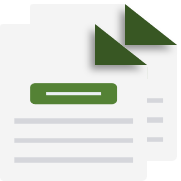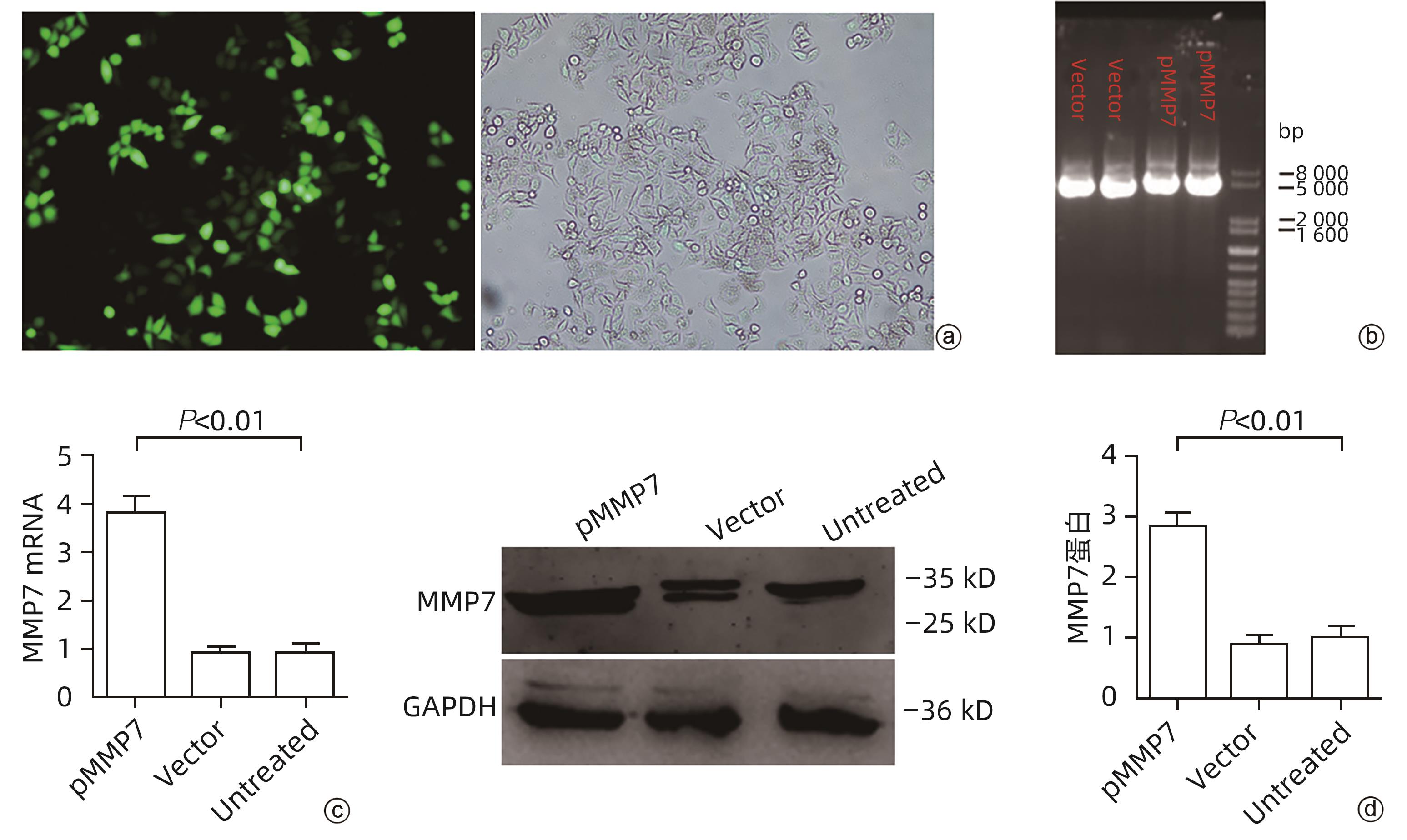基质金属蛋白酶7在肝癌细胞迁移及免疫细胞浸润中的作用与预后价值
DOI: 10.12449/JCH240721
Role and prognostic value of matrix metalloproteinase-7 in the migration and immune cell infiltration of hepatocellular carcinoma
-
摘要:
目的 评估基质金属蛋白酶7(MMP7)在肝癌细胞迁移及免疫细胞浸润中的作用及预后价值。 方法 分别构建下调或上调靶基因MMP7的MMP7_siRNA、pMMP7转染肝癌细胞株(MHCC97H)。采用RT-qPCR、Western Blot分别检测细胞中靶基因mRNA及蛋白的表达水平。扫描电镜和Transwell小室实验分别观察细胞伪足和迁移能力的变化,并采用生物信息学的方法,在TCGA、TIMER数据库分析MMP7与免疫细胞及肝癌患者免疫浸润评分之间的相关性,并进一步研究MMP7与肝癌患者预后的相关性。相关性分析采用Spearman方法。Sanger Box在线工具评估MMP7在肝癌总体生存期、疾病特异性生存期方面的意义。Kaplan-Meier法绘制生存曲线,Log-rank检验评估不同组样本之间的预后差异。 结果 构建的MMP7_siRNA、pMMP7转染MHCC97H细胞后均能有效下调或上调靶基因MMP7的表达,在MHCC97H细胞中MMP7被干扰后细胞伪足明显减少,并且变短,但是过表达MMP7之后细胞表面丝状伪足数量明显增多,并且伪足长度变长,放射状排列。Transwell小室结果发现,MMP7_siRNA2能够显著降低细胞迁移能力(P<0.05),而转染pMMP7后,细胞迁移能力显著增加(P<0.05)。MMP7的表达与B淋巴细胞(r=0.37)、CD4+T淋巴细胞(r=0.40)、中性粒细胞(r=0.49)、巨噬细胞(r=0.49)、树突状细胞(r=0.47)显著相关(P值均<0.05)。在TCGA数据库中,基于总体生存期最佳截断值将肝癌患者分成MMP7高表达组(n=267)和MMP7低表达组(n=146),结果发现,MMP7高表达组的总体生存期明显低于MMP7低表达组(P<0.05);基于疾病特异性生存期最佳截断值将肝癌患者分成MMP7高表达组(n=257)和MMP7低表达组(n=145),结果发现,MMP7高表达组的疾病特异性生存期也低于MMP7低表达组(P<0.05)。 结论 MMP7促进了肝癌细胞的迁移,并在免疫细胞浸润中发挥主要作用,MMP7的表达也与肝癌的预后具有明显相关性。 Abstract:Objective To investigate the role and prognostic value of matrix metalloproteinase-7 (MMP7) in the migration and immune cell infiltration of hepatocellular carcinoma. Methods MMP7_siRNA for downregulating the target gene MMP7 and pMMP7 for upregulating MMP7 were constructed and were used to transfect hepatocellular carcinoma cell line (MHCC97H). RT-qPCR and Western Blot were used to measure the mRNA and protein expression levels of the target gene in cells. Scanning electron microscopy and Transwell assay were used to observe the changes in cell pseudopodia and migration ability, and bioinformatics methods were used to investigate the correlation of MMP7 with immune cells and immune infiltration score in TCGA and TIMER databases in patients with hepatocellular carcinoma, as well as the association between MMP7 and the prognosis of patients with hepatocellular carcinoma. The Spearman method was used for correlation analysis. Sanger Box online tool was used to assess the value of MMP7 in the overall survival curve and disease-specific survival of hepatocellular carcinoma. The Kaplan-Meier method was used to plot survival curves, and the Log-rank test was used for comparison of prognosis between different samples. Results After MHCC97H cells were transfected with MMP7_siRNA or pMMP7, there was a significant reduction or increase in the expression of the target gene MMP7; after downregulation of MMP7, there were significant reductions in the number and length of the pseudopodia, while after MMP7 overexpression, there were significant increases in the number and length of filopodia with radial arrangement. The Transwell chamber assay showed that MMP7_siRNA2 significantly reduced the migration ability of cells (P<0.05), and there was a significant increase in migration ability after pMMP7 transfection. The expression of MMP7 was significantly correlated with B lymphocytes (r=0.37, P<0.05), CD4+ T lymphocytes (r=0.40, P<0.05), neutrophils (r=0.49, P<0.05), macrophages (r=0.49, P<0.05), and dendritic cells (r=0.47, P<0.05). In the TCGA database, the patients with hepatocellular carcinoma were divided into MMP7 high expression group with 267 patients and MMP7 low expression group with 146 patients based on overall survival, and the results showed that the MMP7 high expression group had a significantly shorter overall survival time than the MMP7 low expression group (P<0.05); based on the disease-specific survival time, the patients were divided into MMP7 high expression group with 257 patients and MMP7 low expression group with 145 patients, and the analysis showed that the MMP7 high expression group also had a significantly shorter disease-specific survival time than the MMP7 low expression group (P<0.05). Conclusion MMP7 promotes the migration of hepatocellular carcinoma cells and plays a major role in immune cell infiltration, and the expression of MMP7 is also significantly associated with the prognosis of hepatocellular carcinoma. -
Key words:
- Liver Neoplasms /
- Matrix Metalloproteinase 7 /
- Cell Movement
-
肝移植是治疗终末期肝病的有效疗法,免疫排斥是限制肝移植发展的重要因素[1-2]。肝移植术后常用的免疫抑制剂(immunosuppressive,IS)包括:钙调磷酸酶抑制剂、霉酚酸酯、雷帕霉素、糖皮质激素等,长期使用这些药物存在较多不良反应[3-5]。因此,肝移植术后免疫抑制治疗的研究方向是寻找新型药物,在抑制免疫排斥和降低IS毒副作用之间取得平衡。
间充质干细胞(mesenchymal stem cells,MSC)是一种具有自我更新能力和多向分化潜能的多能干细胞,具有抗炎、抗氧化、抗凋亡、调节免疫等作用,被认为是肝病治疗的理想药物[6-9]。本研究建立原位肝移植大鼠模型,探讨单用MSC、单用IS、MSC联合IS抑制大鼠肝移植免疫排斥反应的效果,为进一步研究MSC在大鼠肝移植中的应用奠定基础。
1. 材料与方法
1.1 实验动物
3周龄清洁级雄性F344大鼠,体质量50~70 g,用来提取MSC;8周龄清洁级雄性F344大鼠,体质量260~270 g,为肝移植供体;8周龄清洁级雄性Lewis大鼠,体质量275~285 g,为肝移植受体。以上实验动物均购自北京维通利华实验动物技术有限公司,实验动物生产许可证编号:SCXK(京)2019-0008,实验动物使用许可证编号:SYXK(闽)2022-0003。
1.2 实验试剂
α-MEM培养基(美国Hyclone公司);胎牛血清(美国Gibco公司);双抗(美国Gibco公司);0.25%胰酶(美国Gibco公司);苏木素伊红(HE)染色试剂盒(北京索莱宝公司);Masson三色染色试剂盒(北京索莱宝公司);CD3抗体(武汉赛维尔公司);CD56抗体(武汉赛维尔公司)。
1.3 实验方法
1.3.1 MSC的体外分离、培养和鉴定
将3周龄F344大鼠处死,无菌分离双下肢骨,用α-MEM培养基反复冲洗骨髓腔,移入培养瓶中,置于37 ℃、5% CO2恒温培养箱培养。2 h后吸取上清,继续培养,去除快速贴壁细胞。24 h后更换培养基,去除不贴壁细胞。以后每隔2 d更换培养基,直至细胞融合度达到90%,用0.25%胰酶消化,传代培养。后续实验均使用P3代细胞。
将P3代细胞消化、重悬,PBS清洗2次,使用5%BSA孵育20 min,PBS清洗2次,分别加入含CD44、CD105、CD34、CD31的0.5% BSA,室温避光孵育30 min,PBS清洗2次,上机检测。
1.3.2 大鼠肝移植模型建立与分组
采用Kamada双袖套法,不重建肝动脉[10]。F344大鼠为供体,Lewis大鼠为受体,其中供体体质量略小于受体。各组手术无肝期为13~15 min,总时间为100~120 min,差异无统计学意义。术后大鼠单笼喂养,自由饮水、进食。
实验分为5组,每组8只大鼠。Normal组:正常大鼠,即不进行任何干预的正常大鼠;其余组均进行大鼠原位肝移植,PS组注射生理盐水;MSC组注射MSC(分别在术前7 d、手术当天、术后7 d、术后15 d注射,每次每只大鼠注射3×106 MSC);IS组注射IS(氢化可的松0.75 mg·kg-1·d-1、环孢霉素1 mg·kg-1·d-1),MSC+IS组注射MSC和IS。
1.3.3 病理切片染色
取肝移植术后15 d肝组织,用4%多聚甲醛室温固定24 h,石蜡包埋,切片。分别使用苏木素伊红(HE)染色试剂盒和Masson染色试剂盒染色,封片镜检。Masson染色结果使用Image J软件量化。
1.3.4 免疫组化
取肝移植术后15 d肝组织,用4%多聚甲醛室温固定24 h,石蜡包埋,切片。切片常规脱蜡至水,EDTA抗原修复,3%的双氧水处理,血清封闭,一抗4 ℃过夜孵育,二抗室温孵育30 min,DAB显色,苏木素染核,封片镜检,阳性细胞数使用Image J软件量化。
1.3.5 免疫荧光
取肝移植术后15 d肝组织,用4%多聚甲醛室温固定24 h,石蜡包埋,切片。切片常规脱蜡至水,EDTA抗原修复,血清封闭,一抗4 ℃过夜孵育,二抗室温孵育2 h,DAPI染核,封片镜检,共定位细胞占比使用Image J软件量化。
1.4 统计学方法
采用GraphPad Prism 9.5进行数据分析。计量资料多组间比较采用单因素方差分析,进一步两两比较采用LSD-t检验。Kaplan-Meier法绘制生存曲线,生存分析采用Log-rank检验。P<0.05为差异有统计学意义。
2. 结果
2.1 MSC的鉴定
原代培养2 d时细胞呈梭形,细胞轮廓清晰(图1)。原代培养10 d左右细胞融合度达到90%,传代后生长良好,杂细胞减少。利用流式细胞仪检测MSC的表面标志物,结果显示P3代细胞的纯度高,细胞表面抗原CD44、CD105、CD34、CD31的阳性率分别为97.7%、94.3%、2.02%、1.55%(图2)。
2.2 生存分析
每组各留5只大鼠观察生存期,共观察60 d。其中Normal组无死亡,PS组在术后20 d之内全部死亡,MSC组和IS组在观察结束时均存活2只,MSC+IS组在观察结束时仅1只死亡(图3)。与Normal组相比,PS组大鼠生存期显著缩短(P<0.001)。与PS组相比,MSC+IS组大鼠生存期显著延长(P<0.05)。其余组别之间均无统计学差异(P值均>0.05)。
2.3 各组大鼠肝组织病理学检查结果的比较
肝移植术后第15天,各组大鼠均发生不同程度的排斥反应。HE染色结果(图4)显示:PS组汇管区大量炎症细胞浸润,肝窦结构紊乱,静脉内皮炎症明显,大部分胆管结构不完整,炎症累及周围肝实质;MSC组和IS组部分汇管区可见炎症细胞浸润;MSC+IS组几乎没有汇管区存在炎症细胞浸润,其肝组织结构接近于Noraml组。4组相比较,PS组排斥反应程度最高,MSC组和IS组程度相似,MSC+IS组排斥程度最低。根据Masson染色结果(图4、5)可知:PS组纤维化程度最高(15.46±0.79)%,MSC+IS组程度最低(3.60±0.54)%。与Normal组相比,PS组纤维化程度显著升高(P<0.000 1)。与PS组相比,MSC组、IS组和MSC+IS组纤维化程度均显著降低(P值均<0.000 1)。MSC+IS组纤维化程度显著低于MSC组和IS组(P值均<0.000 1)。
2.4 各组大鼠肝组织T淋巴细胞和NK细胞浸润情况
选择CD56和CD3两个指标进行免疫组化染色,观察大鼠肝组织T淋巴细胞和NK细胞的浸润情况。T淋巴细胞和NK细胞都主要分布在汇管区,个别T淋巴细胞浸润到肝实质(图6a)。统计结果如图所示(图6b、c),PS组中T淋巴细胞和NK细胞浸润最严重,MSC+IS组浸润程度最低。与Normal组相比,PS组T淋巴细胞和NK细胞浸润程度显著升高(P<0.000 1)。与PS组相比,MSC组、IS组和MSC+IS组T淋巴细胞与NK细胞浸润程度显著降低(P值均<0.000 1)。
2.5 各组大鼠肝组织巨噬细胞M2极化情况
CD68(巨噬细胞标志物)和CD163(巨噬细胞M2极化相关标志物)双重免疫荧光染色结果显示,与Normal组相比,PS组中CD68和CD163共定位细胞数占比显著降低(P<0.05);与PS组相比,MSC组、IS组和MSC+IS组中共定位占比显著增加(P值均<0.000 1),且MSC+IS组与MSC组及IS组相比差异均有统计学意义(P值均<0.000 1)(图7、8)。
3. 讨论
MSC是一类多能干细胞,具有多向分化潜能和免疫调节作用。其表面低表达组织相容性复合物,具有低免疫原性,不刺激体内免疫反应[8]。多项体内、体外实验[11-13]均表明,MSC可向肝细胞分化,修复受损肝组织,降低炎症反应。本研究同样证实了MSC具有免疫调节作用,其抑制大鼠肝移植免疫排斥反应能力与IS相当,但不论是MSC还是IS均未达到最理想疗效。
免疫排斥反应是肝移植术后常见的病理生理过程,是导致肝移植失败的重要原因[14]。目前,尚无统一的肝移植术后IS治疗标准,多采用以钙调磷酸酶抑制剂为基础,联合其他药物的免疫抑制方案。常用的三联免疫抑制方案为钙调磷酸酶抑制剂+霉酚酸酯+糖皮质激素,常用的二联免疫抑制方案为钙调磷酸酶抑制剂+霉酚酸酯/糖皮质激素[3]。由于IS的毒副作用,针对特殊肝移植受者,如:肾功能损伤、糖尿病、高血压等,常规二联和三联免疫抑制方案的使用受限,现有IS方案已不能满足临床需求[15-16]。
本研究通过构建原位肝移植大鼠模型,注射MSC和IS,观察MSC联合IS抑制免疫排斥的能力。结果显示:与MSC组和IS组相比,MSC+IS组术后15 d肝组织炎症细胞浸润明显少于MSC组和IS组,肝小叶结构完整,基本接近于Normal组。且MSC+IS组降低大鼠肝移植引起的纤维化程度的能力也比MSC组和IS组强。免疫组化进一步分析肝组织炎症细胞浸润情况,结果发现:PS组可见大量T淋巴细胞和NK细胞浸润,MSC组和IS组的浸润明显减少,MSC+IS组仅见少量T淋巴细胞和NK细胞浸润。巨噬细胞M2极化可抑制免疫反应,因此,在肝移植术后增加巨噬细胞M2极化有助于抑制免疫反应,本研究免疫荧光实验也表明,MSC+IS组可以显著增加巨噬细胞M2极化,抑制免疫反应。
综上所述,MSC联合IS可以抑制大鼠原位肝移植免疫排斥反应。
-
表 1 siRNA 序列
Table 1. Sequences of siRNA
基因名称 序列(5′-3′) MMP7_siRNA1 正义链 GGAAAGAGAAGUAAUUCAAdTdT 反义链 UUGAAUUACUUCUCUUUCCdTdT MMP7_siRNA2 正义链 GACGGAUGGUAGCAGUCUAdTdT 反义链 UAGACUGCUACCAUCCGUCdTdT MMP7_siRNA3 正义链 CGAUUAGUGUCAAAGGCUUdTdT 反义链 AAGCCUUUGACACUAAUCGdTdT MMP7_siRNA4 正义链 GCAUUUCAGGAAAGUUGUAdTdT 反义链 UACAACUUUCCUGAAAUGCdTdT NC_siRNA 正义链 UUCUCCGAACGUGUCACGUdTdT 反义链 ACGUGACACGUUCGGAGAAdTdT 表 2 RT-qPCR 引物序列
Table 2. Sequences of RT-qPCR primers
基因名称 序列(5′-3′) 长度(bp) MMP7 F:ACAGGCTCAGGACTATCTCAAG 179 R:CAACATCTGGCACTCCACATC GAPDH F:GAAGGTGAAGGTCGGAGTC 226 R:GAAGATGGTGATGGGATTTC -
[1] SUNG H, FERLAY J, SIEGEL RL, et al. Global cancer statistics 2020: GLOBOCAN estimates of incidence and mortality worldwide for 36 cancers in 185 countries[J]. CA Cancer J Clin, 2021, 71( 3): 209- 249. DOI: 10.3322/caac.21660. [2] CRISTESCU R, MOGG R, AYERS M, et al. Pan-tumor genomic biomarkers for PD-1 checkpoint blockade-based immunotherapy[J]. Science, 2018, 362( 6411): eaar3593. DOI: 10.1126/science.aar3593. [3] THOMPSON SM, CALLSTROM MR, JONDAL DE, et al. Heat stress-induced PI3K/mTORC2-dependent AKT signaling is a central mediator of hepatocellular carcinoma survival to thermal ablation induced heat stress[J]. PLoS One, 2016, 11( 9): e0162634. DOI: 10.1371/journal.pone.0162634. [4] MASUZAKI R, YOSHIDA H, TATEISHI R, et al. Hepatocellular carcinoma in viral hepatitis: Improving standard therapy[J]. Best Pract Res Clin Gastroenterol, 2008, 22( 6): 1137- 1151. DOI: 10.1016/j.bpg.2008.11.005. [5] HERNANDEZ-GEA V, TOFFANIN S, FRIEDMAN SL, et al. Role of the microenvironment in the pathogenesis and treatment of hepatocellular carcinoma[J]. Gastroenterology, 2013, 144( 3): 512- 527. DOI: 10.1053/j.gastro.2013.01.002. [6] CHEN JF, LU XL, ZHANG XY, et al. Expression and clinical significance of matrix metalloproteinase 7 and heparan sulfate proteoglycan 2 in pancreatic cancer[J]. J Clin Hepatol, 2023, 39( 9): 2169- 2174. DOI: 10.3969/j.issn.1001-5256.2023.09.020.陈金凤, 陆小柳, 张晓韵, 等. 基质金属蛋白酶7(MMP7)和硫酸乙酰肝素糖蛋白2(HSPG2)在胰腺癌中的表达及临床意义[J]. 临床肝胆病杂志, 2023, 39( 9): 2169- 2174. DOI: 10.3969/j.issn.1001-5256.2023.09.020. [7] CHEN L, KE XY. MMP7 as a potential biomarker of colon cancer and its prognostic value by bioinformatics analysis[J]. Medicine, 2021, 100( 9): e24953. DOI: 10.1097/MD.0000000000024953. [8] LI XF, AIERKEN ALD, SHEN L. IPO5 promotes malignant progression of esophageal cancer through activating MMP7[J]. Eur Rev Med Pharmacol Sci, 2020, 24( 8): 4246- 4254. DOI: 10.26355/eurrev_202004_21004. [9] GOBIN E, BAGWELL K, WAGNER J, et al. A pan-cancer perspective of matrix metalloproteases(MMP) gene expression profile and their diagnostic/prognostic potential[J]. BMC Cancer, 2019, 19( 1): 581. DOI: 10.1186/s12885-019-5768-0. [10] DING XX, ZHU QG, ZHANG SM, et al. Precision medicine for hepatocellular carcinoma: Driver mutations and targeted therapy[J]. Oncotarget, 2017, 8( 33): 55715- 55730. DOI: 10.18632/oncotarget.18382. [11] LI TW, FAN JY, WANG BB, et al. TIMER: A web server for comprehensive analysis of tumor-infiltrating immune cells[J]. Cancer Res, 2017, 77( 21): e108- e110. DOI: 10.1158/0008-5472.CAN-17-0307. [12] XU WX, ZHANG J, HUA YT, et al. An integrative pan-cancer analysis revealing LCN2 as an oncogenic immune protein in tumor microenvironment[J]. Front Oncol, 2020, 10: 605097. DOI: 10.3389/fonc.2020.605097. [13] GTEX CONSORTIUM. The genotype-tissue expression(GTEx) project[J]. Nat Genet, 2013, 45( 6): 580- 585. DOI: 10.1038/ng.2653. [14] SHEN W, SONG Z, ZHONG X, et al. Sangerbox: A comprehensive, interaction-friendly clinical bioinformatics analysis platform[J]. Imeta, 2022, 1( 3): e36. https://doi.org/10.1002/imt2.36 DOI: 10.1002/imt2.36 [15] AJUCARMELPRECILLA A, PANDI J, DHANDAPANI R, et al. In silico identification of hub genes as observing biomarkers for gastric cancer metastasis[J]. Evid Based Complement Alternat Med, 2022, 2022: 6316158. DOI: 10.1155/2022/6316158. [16] RAJENDRAN L, IVANICS T, CLAASEN MP, et al. The management of post-transplantation recurrence of hepatocellular carcinoma[J]. Clin Mol Hepatol, 2022, 28( 1): 1- 16. DOI: 10.3350/cmh.2021.0217. [17] YANG JD, HAINAUT P, GORES GJ, et al. A global view of hepatocellular carcinoma: Trends, risk, prevention and management[J]. Nat Rev Gastroenterol Hepatol, 2019, 16( 10): 589- 604. DOI: 10.1038/s41575-019-0186-y. [18] LEOWATTANA W, LEOWATTANA T, LEOWATTANA P. Systemic treatment for unresectable hepatocellular carcinoma[J]. World J Gastroenterol, 2023, 29( 10): 1551- 1568. DOI: 10.3748/wjg.v29.i10.1551. [19] ZAVADIL J, ROHAN T, JURÁČEK J, et al. Biomarkers as prognostic and predictive factors in patients with hepatocellular carcinoma undergoing radiological oncological interventions[J]. Klin Onkol, 2023, 36( 2): 104- 111. DOI: 10.48095/ccko2023104. [20] ZHANG JF, ZHANG J. Research progress on diagnosis and treatments for microvascular invasion of hepatocellular carcinoma[J/CD]. Chin J Hepat Surg(Electronic Edition), 2022, 11( 1): 104- 108. DOI: 10.3877/cma.j.issn.2095-3232.2022.01.022.张剑锋, 张剑. 肝细胞癌微血管浸润诊治研究进展[J/CD]. 中华肝脏外科手术学电子杂志, 2022, 11( 1): 104- 108. DOI: 10.3877/cma.j.issn.2095-3232.2022.01.022. [21] SZARVAS T, CSIZMARIK A, VÁRADI M, et al. The prognostic value of serum MMP-7 levels in prostate cancer patients who received docetaxel, abiraterone, or enzalutamide therapy[J]. Urol Oncol, 2021, 39( 5): 296. DOI: 10.1016/j.urolonc.2020.09.005. [22] TREGUNNA R. Serum MMP7 levels could guide metastatic therapy for prostate cancer[J]. Nat Rev Urol, 2020, 17( 12): 658. DOI: 10.1038/s41585-020-00396-3. [23] DU F, FENG WB, CHEN S, et al. Sex determining region Y-box 12(SOX12) promotes gastric cancer metastasis by upregulating MMP7 and IGF1[J]. Cancer Lett, 2019, 452: 103- 118. DOI: 10.1016/j.canlet.2019.03.035. [24] JAFFAR J, WONG M, FISHBEIN GA, et al. Matrix metalloproteinase-7 is increased in lung bases but not apices in idiopathic pulmonary fibrosis[J]. ERJ Open Res, 2022, 8( 4): 00191- 02022. DOI: 10.1183/23120541.00191-2022. [25] SANG HY, WU S, CHEN XF, et al. FAM46B suppresses proliferation, migration and invasion of non-small cell lung cancer via β-catenin/MMP7 signaling[J]. Transl Cancer Res, 2019, 8( 4): 1497- 1505. DOI: 10.21037/tcr.2019.07.27. [26] RONG WQ, ZHANG Y, YANG L, et al. Post-surgical resection prognostic value of combined OPN, MMP7, and PSG9 plasma biomarkers in hepatocellular carcinoma[J]. Front Med, 2019, 13( 2): 250- 258. DOI: 10.1007/s11684-018-0632-1. [27] YE LT, KRIEGL L, REITER FP, et al. Prognostic significance and functional relevance of olfactomedin 4 in early-stage hepatocellular carcinoma[J]. Clin Transl Gastroenterol, 2020, 11( 1): e00124. DOI: 10.14309/ctg.0000000000000124. [28] HE XX, SHI LL, QIU MJ, et al. Molecularly targeted anti-cancer drugs inhibit the invasion and metastasis of hepatocellular carcinoma by regulating the expression of MMP and TIMP gene families[J]. Biochem Biophys Res Commun, 2018, 504( 4): 878- 884. DOI: 10.1016/j.bbrc.2018.08.203. [29] LIAO LJ, DUAN DY, LIU YF, et al. LHPP inhibits hepatocellular carcinoma cell growth and metastasis[J]. Cell Cycle, 2020, 19( 14): 1846- 1854. DOI: 10.1080/15384101.2020.1783472. [30] JEGGO PA, PEARL LH, CARR AM. DNA repair, genome stability and cancer: A historical perspective[J]. Nat Rev Cancer, 2016, 16( 1): 35- 42. DOI: 10.1038/nrc.2015.4. [31] CHATTERJEE A, RODGER EJ, ECCLES MR. Epigenetic drivers of tumourigenesis and cancer metastasis[J]. Semin Cancer Biol, 2018, 51: 149- 159. DOI: 10.1016/j.semcancer.2017.08.004. [32] CHEN F, FAN YM, CAO PX, et al. Pan-cancer analysis of the prognostic and immunological role of HSF1: A potential target for survival and immunotherapy[J]. Oxid Med Cell Longev, 2021, 2021: 5551036. DOI: 10.1155/2021/5551036. [33] XU ZH, HE CY, FANG XD. Research progress in relationship between mitochondrial inner membrane mitochondrial protein and tumor[J]. J Jilin Univ(Med Edit), 2023, 49( 1): 231- 236. DOI: 10.13481/j.1671-587X.20230131.徐仲航, 何成彦, 房学东. 线粒体内膜蛋白与肿瘤关系的研究进展[J]. 吉林大学学报(医学版), 2023, 49( 1): 231- 236. DOI: 10.13481/j.1671-587X.20230131. [34] LI TW, FU JX, ZENG ZX, et al. TIMER2.0 for analysis of tumor-infiltrating immune cells[J]. Nucleic Acids Res, 2020, 48( W1): W509- W514. DOI: 10.1093/nar/gkaa407. [35] ANGELOVA M, CHAROENTONG P, HACKL H, et al. Characterization of the immunophenotypes and antigenomes of colorectal cancers reveals distinct tumor escape mechanisms and novel targets for immunotherapy[J]. Genome Biol, 2015, 16( 1): 64. DOI: 10.1186/s13059-015-0620-6. [36] LEE N, ZAKKA LR, MIHM MC Jr, et al. Tumour-infiltrating lymphocytes in melanoma prognosis andcancerimmunotherapy[J]. Pathology, 2016, 48( 2): 177- 187. DOI: 10.1016/j.pathol.2015.12.006. [37] DENKERT C, VON MINCKWITZ G, DARB-ESFAHANI S, et al. Tumour-infiltrating lymphocytes and prognosis in different subtypes of breast cancer: A pooled analysis of 3771 patients treated with neoadjuvant therapy[J]. Lancet Oncol, 2018, 19( 1): 40- 50. DOI: 10.1016/S1470-2045(17)30904-X. [38] GALON J, BRUNI D. Approaches to treat immune hot, altered and cold tumours with combination immunotherapies[J]. Nat Rev Drug Discov, 2019, 18( 3): 197- 218. DOI: 10.1038/s41573-018-0007-y. [39] ZHAO YD, SCHAAFSMA E, GORLOV IP, et al. A leukocyte infiltration score defined by a gene signature predicts melanoma patient prognosis[J]. Mol Cancer Res, 2019, 17( 1): 109- 119. DOI: 10.1158/1541-7786.MCR-18-0173. [40] MCGRANAHAN N, SWANTON C. Clonal heterogeneity and tumor evolution: Past, present, and the future[J]. Cell, 2017, 168( 4): 613- 628. DOI: 10.1016/j.cell.2017.01.018. [41] WEI GG, ZHANG HL, ZHAO HP, et al. Emerging immune checkpoints in the tumor microenvironment: Implications for cancer immunotherapy[J]. Cancer Lett, 2021, 511: 68- 76. DOI: 10.1016/j.canlet.2021.04.021. [42] ZHANG YY, ZHANG ZM. The history and advances in cancer immunotherapy: Understanding the characteristics of tumor-infiltrating immune cells and their therapeutic implications[J]. Cell Mol Immunol, 2020, 17( 8): 807- 821. DOI: 10.1038/s41423-020-0488-6. [43] MURCIANO-GOROFF YR, WARNER AB, WOLCHOK JD. The future of cancer immunotherapy: Microenvironment-targeting combinations[J]. Cell Res, 2020, 30( 6): 507- 519. DOI: 10.1038/s41422-020-0337-2. 期刊类型引用(1)
1. 张薇,张庆容,马茂林,冷强华,韩飞. 小鼠心脏移植慢性排斥反应模型的建立和分析. 器官移植. 2025(01): 99-105 .  百度学术
百度学术其他类型引用(0)
-




 PDF下载 ( 4637 KB)
PDF下载 ( 4637 KB)


 下载:
下载:








 下载:
下载:





 百度学术
百度学术









